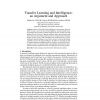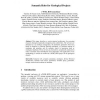LREC
2008
14 years 29 days ago
2008
One of the aims of the Language Technology for eLearning project is to show that Natural Language Processing techniques can be employed to enhance the learning process. To this en...
IRCDL
2008
14 years 29 days ago
2008
Several sites allow users to publish personal reviews about products and services available on the market. In this paper, we consider the problem of applying classification techniq...
COLING
2008
14 years 29 days ago
2008
This paper presents a real-world application for assisting medical diagnosis and drug prescription, which relies on the exclusive use of machine learning techniques. We have autom...
AGI
2008
14 years 29 days ago
2008
In order to claim fully general intelligence in an autonomous agent, the ability to learn is one of the most central capabilities. Classical machine learning techniques have had ma...
ESWS
2008
Springer
14 years 1 months ago
2008
Springer
This paper describes a service-oriented architecture for accessing resources through semantically designed portals called hubs. The services are dedicated to: (a) ontology manageme...
FLAIRS
2007
14 years 1 months ago
2007
Ontologies are an increasingly important tool in knowledge representation, as they allow large amounts of data to be related in a logical fashion. Current research is concentrated...
AAAI
2007
14 years 1 months ago
2007
We present a novel approach to solving Quantified Boolean Formulas (QBF) that combines a search-based QBF solver with machine learning techniques. We show how classification met...
MOBISYS
2010
ACM
14 years 1 months ago
2010
ACM
We present Darwin, an enabling technology for mobile phone sensing that combines collaborative sensing and classification techniques to reason about human behavior and context on ...
KDD
2000
ACM
14 years 3 months ago
2000
ACM
Higher quality synthesized speech is required for widespread use of text-to-speech (TTS) technology, and prosodic pattern is the key feature that makes synthetic speech sound unna...
EENERGY
2010
14 years 3 months ago
2010
As energy-related costs have become a major economical factor for IT infrastructures and data-centers, companies and the research community are being challenged to find better an...


